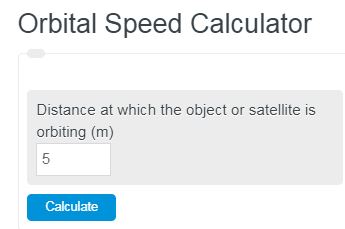Enter the total mass of an object or satellite, and the radius at which it is orbiting to calculate the velocity of that object. This is only valid for an object orbiting Earth in a mostly circular orbit.
- Velocity Calculator
- Acceleration Calculator
- Force Calculator
- Rocket Equation Calculator
- Orbital Acceleration Calculator
- Orbital Kinetic Energy Calculator
Orbital Speed Formula
The formula for orbital speed is the following:
Orbital Speed = SQRT(G*m/r)
- Where G is a gravitational constant (For Earth, G*m = 3.986004418*10^14 (m^3/s^2))
- m is the mass of earth (or other larger body)
- and radius is the distance at which the smaller mass object is orbiting.
If you didn’t recognize it yet, you can see that the velocity of an object orbiting Earth is only dependent on the radius or distance it is orbiting. This is because the mass of the object orbiting the Earth is so small in comparison that it’s negligible. Through some manipulation of the equations, we can actually determine the force or torque required to keep that object at that velocity due to angular acceleration.
The following equation can be use:
F = G*M*m/r^2
Orbital Speed Definition
Orbital speed is defined as the velocity of an object of mass that is rotating around a larger mass. It’s most often considered the average orbital speed since objects in elliptical orbits have varying speeds.
How to calculate orbital speed?
How to calculate orbital speed?
- First, determine the mass of the larger object.
For objects orbiting the earth, this should be 5.972 × 10^24 kg.
- Next, determine the mass of the orbiting object.
Calculate or measure the mass of the orbiting object.
- Next, determine the distance of orbit.
This should be the average distance of orbit.
- Finally, calculate the orbital speed.
Using the formula above, calculate the orbital speed.
FAQ
Orbital speed is the velocity at which an object rotates around a larger body relative to the movement of the larger body.

